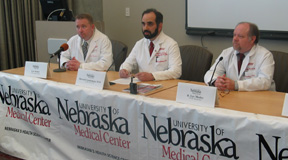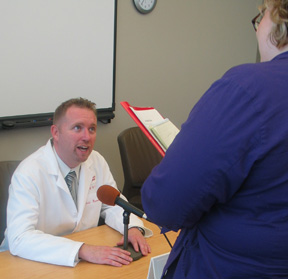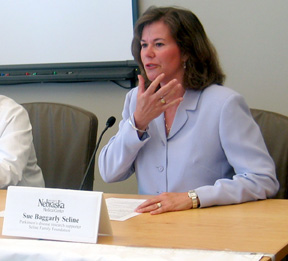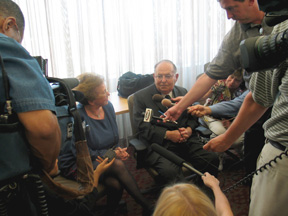 |
UNMC scientists, from left, Eric Benner, Howard Gendelman, M.D., and Lee Mosley, Ph.D., presented initial findings for a vaccine for Parkinson’s disease at a news conference on Monday. |
The findings appear in the Proceedings of the National Academy of Sciences (PNAS) of the United States of America. PNAS is among the world’s most-cited multidisciplinary scientific journals. The report, titled “Therapeutic immunization protects dopaminergic neurons in a mouse model of Parkinson’s disease,” is now online. A print copy will be released June 22.
“It’s a significant conceptual advance for Parkinson’s disease therapy,” said Howard Gendelman, M.D., David T. Purtilo Distinguished Chair of Pathology and Microbiology at UNMC and director of the Center for Neurovirology and Neurodegenerative Disorders (CNND) where the research was conducted. “As of today drugs are available which only treat symptoms of disease. Regrettably, nothing is now available that prevents or reverses the course of brain degeneration. Our vaccine approach changes this by bringing a new excitement to a developing field of investigation; called neuroprotective medicine. A vaccine therapy that protects the dopamine nerve cells damaged in Parkinson’s disease is novel.”
 |
Graduate student Eric Benner explains more about the vaccine to Omaha World-Herald reporter Nichole Aksamit. |
Clinical trials to follow
The discovery, however, is just the beginning, Dr. Gendelman said. More research is being done at UNMC to improve this approach. Some aspects include finding the types of immune cells responsible for the protection as well as developing diagnostic techniques like enhanced magnetic resonance imaging to track disease progression. Clinical trials in humans are being developed at Columbia University.
“This will change how we treat neurodegenerative diseases,” said Harris Gelbard, M.D., Ph.D., professor of neurology at the University of Rochester Medical Center. “It’s a groundbreaking advance.”
Kudos to CNND team
Dr. Gendelman credited Eric Benner, an M.D., Ph.D. student at UNMC, in playing a principal role in developing, then testing the Parkinson’s vaccine approach over the past four years. “It was an incredible feat to integrate state-of-the-art animal research with similar advances in vaccine development,” he said. “Eric simply did an outstanding job.
 |
Sue Baggarly Seline talks about the effect that Parkinson’s disease has had on the smile of her sister, Jackie Farrar. |
Containing a destructive process
The CNND has based much of its research on the premise that activation of two types of support cells in the brain – microglia and astrocytes – mediate inflammatory events that contribute to the death of neurons, the nerve cells in the nervous system that receive and send out electrical signals.
“The destruction of neurons in this way is well known to lead to the development of neurodegenerative disorders such as Parkinson’s disease, Alzheimer’s disease and HIV-1-associated dementia,” Benner said. “The vaccine approach can affect the inflammatory brain response and at the same time increase the local expression of neurotrophins or nerve cell growth promoting factors in the brain.”
“What we have done is take an evil process (inflammation) and turned it on its heels,” Dr. Gendelman said. “We’ve taken a destructive process and contained it.”
 |
At the end of Monday’s news conference, media members gather to capture the opinions of Louis and Fran Blumkin. Louis Blumkin, chairman emeritus of the Nebraska Furniture Mart, was diagnosed with Parkinson’s disease about four years ago. |
Drs. Gendelman and Przedborski and Benner emphasized that although the vaccine protects mice against the type of cell death observed in Parkinson’s disease, there is no guarantee it will act the same way in humans. Clinical trials ultimately will determine if the observations seen in mice can be translated and prove useful in humans with disease.
Vaccine shows promise in mice
In mice, however, the concept has shown great promise, preventing the progression of the disease. In their research, CNND scientists injected an immunogen that cross reacts with myelin basic protein into mice with an experimental form of Parkinson’s disease. “The mice mounted an immune response that affected inflammatory responses in the brain and the production of neurotrophic, or neuronal growth factors,” Benner said.
The immune cells can go into brain regions that are affected during disease and reducee the inflammation in the area of injury, as it would elsewhere in the body following local infections and trauma. This may be a way to use the body’s own defense to work towards its own repair. Importantly such protective strategies eliminate the need to use more controversial approaches for brain repair including the use of embryonic stem cells and fetal cells. Unlike fetal or stem cells, this vaccine therapy relies on harnessing the body’s own immune system. It’s a very novel means for combating neurological diseases.”
More on Parkinson’s disease
Parkinson’s disease is a chronic, debilitating disease without a cure. There also is no preventive or restorative treatment available. In the United States, at least 500,000 people are believed to suffer from Parkinson’s disease, and about 50,000 new cases are reported annually. The incidence is expected to increase as the average age of the population increases. The disorder appears to be slightly more common in men than women.
Vaccine is FDA-approved
The vaccine approach utilizes a compound called Copaxone or Cop-1, a Food and Drug Administration (FDA)-approved and well-tolerated drug. Cop-1 has been used effectively in patients with chronic neuroinflammatory disease such as relapsing remitting multiple sclerosis for more than a decade. Given the safety record for Cop-1 and that current treatments for Parkinson’s disease remain palliative, such a vaccination strategy represents a promising therapeutic avenue that can readily be used in human clinical trials, said Drs. Gendelman and Przedborski.
Benner studied the mouse model of Parkinson’s disease in Dr. Przedborski’s laboratory and transferred it to Dr. Gendelman’s laboratory in Nebraska. The discovery of Cop-1 was made at the Weizmann Institute nearly three decades ago.
Team approach
Benner, who performed the vaccine studies under the mentorship of Dr. Gendelman, is credited with the advance, along with other CNND and Columbia scientists including, but not only, R. Lee Mosley, Ph.D., an expert immunologist and vaccine specialist at UNMC; Travis B. Lewis, a technician and current M.D., Ph.D., student at the University of Alabama at Birmingham; and Vernice Jackson-Lewis, Ph.D., a well-respected and accomplished neuroscientist at Columbia.
Generous support makes research possible
The work was supported in part, by the National Institutes of Neurological Disorders and Stroke, the U.S. Department of Defense, the Alan and Marcia Baer Foundation, the Francis and Louis Blumkin Foundation, Inc., the Terry K. Watanabe Charitable Trust, the Seline Family Foundation, the Lowenstein Foundation, the Lillian Goldman Charitable Trust, the Parkinson’s Disease Foundation and the MDA/Wings-Over-Wall Street.
The CNND’s novel research in this area was made possible by financial support from several individuals in the Omaha community, Dr. Gendelman said. “Their generous support allows us to be world leaders in a new and dynamic field of investigation,” he said. “It also gives new hope to people with Parkinson’s disease.”